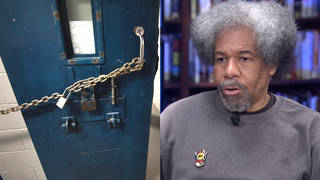
Guests
- Albert Woodfoxthe longest-standing solitary confinement prisoner in the United States. He was held in isolation in a 6-by-9-foot cell almost continuously for 43 years. He was released in 2016 and has just published his new memoir, Solitary: Unbroken by Four Decades in Solitary Confinement. My Story of Transformation and Hope.
Albert Woodfox is a former political prisoner who was held in solitary confinement for 43 years until he won his freedom just over three years ago. Now he is traveling the world and joins us in studio to discuss his new memoir, “Solitary: Unbroken by Four Decades in Solitary Confinement. My Story of Transformation and Hope.” In it, he writes about his childhood and how his mother struggled to keep the family cared for, how as a teenager and young man he was in and out of jails and prisons, and how he became radicalized when he met members of the Black Panther Party and went on to establish the first chapter of the organization at the Louisiana State Penitentiary in Angola, Louisiana, to address horrific conditions at the former cotton plantation. Not long after this, he and fellow prisoner Herman Wallace were accused in 1972 of stabbing prison guard Brent Miller. The two men always maintained their innocence, saying they were targeted because of their political activity. Woodfox, Wallace and and a third man, Robert King, became collectively known as the Angola 3. For decades Amnesty International and other groups campaigned for their release. “Solitary confinement … is the most horrible and brutal nonphysical attack upon a human being,” Woodfox says.
Transcript
AMY GOODMAN: This is Democracy Now! I’m Amy Goodman, with Juan González.
JUAN GONZÁLEZ: Well, we spend the rest of the hour with a former political prisoner who was held in solitary confinement for 43 years until he won his freedom just over three years ago. Albert Woodfox is now traveling the world to discuss his new memoir, Solitary: Unbroken by Four Decades in Solitary Confinement. My Story of Transformation and Hope. In it, he writes about his childhood and how his mother struggled to keep the family cared for, how as a teenager and a young man he was in and out of jails and prisons, and how he became radicalized when he met members of the Black Panther Party, and went on to establish the first chapter of the organization at the Louisiana State Penitentiary in Angola to address horrific conditions at the former cotton plantation. Not long after this, he and fellow prisoner Herman Wallace were accused in 1972 of stabbing prison guard Brent Miller. The two men always maintained their innocence, saying they were targeted because of their political activity. Woodfox, Wallace and a third man, Robert King, became collectively known as the Angola 3. For decades, Amnesty International and other groups campaigned for their release.
AMY GOODMAN: Robert King was freed in 2001, when his conviction, that he had killed a fellow inmate, was overturned. Herman Wallace was freed in 2013, only after a federal judge threatened to jail the warden of Angola prison if he refused to release him that day. Wallace died one day later of liver cancer.
But Louisiana refused to release Albert Woodfox until years later. The state successfully tried him a second time in 1998, after his first conviction was overturned. Then, in 2014, a federal judge ruled he should be set free on the basis of racial discrimination in his retrial. When Louisiana Attorney General Buddy Caldwell announced plans to try Woodfox yet again, U.S. Middle District Court Judge James Brady ordered his release, but the U.S. 5th Circuit then approved Woodfox’s continued detention. Then, after being held in isolation in a 6-by-9-foot cell almost continuously for 43 years, Woodfox was released on his 69th birthday, February 19th, 2016, after he entered a plea of no contest to charges of manslaughter and aggravated burglary. When he left the jail, where he’d been held pending his trial, his first stop was to visit the gravesite of his mother, who died while he was in prison.
ALBERT WOODFOX: I need to go say goodbye to my mother. I wasn’t allowed to go to her funeral when I was in Angola, and my sister, as well.
AMY GOODMAN: That was 2016. Now, two years later, Albert Woodfox joins us here in our New York studio to discuss his incredible new memoir, Solitary: Unbroken by Four Decades in Solitary Confinement. My Story of Transformation and Hope.
We welcome you back to Democracy Now!, Albert Woodfox. We spoke to you the day after you were released. We have followed your case for so long. I was just thinking about the time that you and Robert King—you were in prison, Robert King was free—you were the Angola 3—went to visit Herman Wallace to say goodbye to him. He was dying in prison, dying of cancer. And as Robert came in from the free world and you were brought in, in shackles, you both learned that the judge had demanded Herman Wallace be freed immediately. And is it true you were the ones who gave Herman that news?
ALBERT WOODFOX: You know, it was a momentous occasion, and it was totally, you know, something that none of us expected. The reason Robert and I were there is that, for years, the state of Louisiana had denied us the right to meet with our attorney as a group. And finally, our attorneys went to court, and Judge Brady ordered them to allow us to have group sessions with our attorney. So what the state did was they moved Herman to the farthest southern part of the state, and they created the CCR tier in a correctional facility called Wade, which is at the utmost northern part of the state, to make it very difficult for our attorneys to have group counseling. And so, as a result of that, I had to travel with some six, seven hours each time we had the thing. And—
AMY GOODMAN: And this was, though, your last time seeing Herman?
ALBERT WOODFOX: Well, we actually had three visits. The first visit, you know, Herman had just got the diagnosis, because, you know, up to a certain point the state medical staff was telling him he had an allergy. And it was only after our attorneys hired a generic doctor to come in and examine both Herman and I that they transferred him to a hospital in New Orleans, and he got the diagnosis that he had liver cancer.
AMY GOODMAN: I wanted to go to a clip of Herman, in his own words, describing the impact of solitary confinement on his body. He spoke in phone calls from the prison that were featured in the documentary Herman’s House.
HERMAN WALLACE: Being in a cage for such an extended period of time, it has its downfalls. I mean, you may not feel it, you may not know it, you may think that you’re OK, and you just perfunctorily move about, you know. However, when you was removed from out of that type of situation and placed in an open environment where, you know, you’re even breathing that oxygen and it’s getting into your lungs and you’re feeling something growing within you, and—you begin to develop a different mode within your body. I even watched my body. I’ve looked in the mirror, and I’ve seen muscles and [bleep] begin to pop out there. I began to run even faster and [bleep]. And I’m saying, “Whoa, what the hell is going on here?” Much was preserved. But then I got locked up again after eight months. And being locked up like that, the whole body just got confused.
AMY GOODMAN: That’s a clip of Herman Wallace speaking in Herman’s House. This is Herman describing a dream he had. Listen carefully.
HERMAN WALLACE: I’ve had a dream where I got to the front gate, and there’s a whole lot of people out there. And you ain’t going to believe this, but I was dancing my way out. I was doing the jitterbug. I was doing all kind of crazy, stupid-ass [bleep], you know? And people was just laughing and clapping and [bleep], you know, until I walked out that gate. And I remember that dream, and I turn around, you know, and I look, and there are all the brothers in the window waving and throwing the fist sign, you know? It’s—it’s rough, man. It’s so real, you know. I can feel it even now, you know, talking about that.
AMY GOODMAN: That’s Herman Wallace describing what it would feel to be free. You’ve just celebrated, Albert Woodfox, your 72nd birthday.
ALBERT WOODFOX: Yes, and also the third year of freedom.
AMY GOODMAN: And how do you feel today? How have you adjusted, after 43 years in prison?
ALBERT WOODFOX: Well, hopeful. You know, Rob and I still travel around, across America and outside of America, to talk about solitary confinement, which we believe is the most horrible and brutal nonphysical attack upon a human being by another human being. Throughout my four decades-plus of solitary confinement, I’ve watched men go insane, I’ve watched men physically hurt themselves, you know, trying to deal with the pressure of being confined to a 9-by-6 cell 23 hours out of every 24-hour period. And being free now, I still suffer, you know, claustrophobic attacks. I’m able to address them better now because my physical movement is beyond nine feet now. And so, you know, I can walk in my house. I can go in the backyard of my house. I can go on the sidewalk, or there’s a park, which I often visit, a block and a half away from my house. So, the only remedy for me when I had claustrophobic attacks was the space. So this has made it easier to deal with those attacks.
JUAN GONZÁLEZ: I wanted to go back, because your book is really a gripping account, since so much of your life, of your adult life, was spent in and out of jails and then, of course, in Angola. If you could talk somewhat about your early childhood? And you were—as you begin in the book, you say you were born the “Negro” wing of the Charity Hospital. And talk about your early days in the family, the time you spent with a stepfather who was in the military, so you were traveling—
ALBERT WOODFOX: Yes.
JUAN GONZÁLEZ: —around, living in different parts of the country.
ALBERT WOODFOX: Yes. You know, I would imagine my childhood, you know, you’re aware of your condition based upon the level of consciousness. And so, my childhood was typical, I would imagine, because I had nothing to compare it to. I knew no better lifestyle. My dad was a career military man. He served in the Navy for 20-plus years. And at some point in time, you know, he was mustered out. He was forced to retire. And being a mass chief, you know, and he was in charge of the galleys on an aircraft carrier, he had a great deal of responsibility and respect. But after—you know, and there’s the world of the military, and there’s the world of reality. So, after being mustered out, we moved back to a small town in North Carolina, La Grange. And we lived, and the world of reality began to get in where, you know, he was constantly being disrespected. It was difficult to get a job. And it affected him in a way where he became abusive. And the abuse got to the point where my aunties pleaded with my mom to leave him, because she felt as though if we would stay there, eventually he might kill them in one of his rages.
And so, you know, from that point on, I became a single-parent house. And my mom, you know, was functionally illiterate; she could only read and write her name. But as time went on, I began to realize that in spite of this handicap, she was one of the most wisest women I had ever known. And even to this day—you know, there’s a book—a poem in my book called “Echoes.” Even to this day, you know, there are times when I’m perplexed by a situation, that I can hear echoes of some of the things she would say to me, and she still serves me as well as she did when I was a child.
AMY GOODMAN: We’re going to come back to this discussion, Albert Woodfox, the longest-standing solitary confinement prisoner in the United States, held in a 6-foot-by-9-foot cell almost continuously for 43 years, released just over two years ago. We’ll be back with him in 30 seconds.
[break]
AMY GOODMAN: “Jackie’s First Letter” by Ken Myhr. I’m Amy Goodman, with Juan González. Our guest, Albert Woodfox, author of now his memoir, Solitary: Unbroken by Four Decades in Solitary Confinement. My Story of Transformation and Hope.
JUAN GONZÁLEZ: Well, Albert, you talked about your mother eventually left your father, and she moved back to New Orleans, where—
ALBERT WOODFOX: New Orleans, yes.
JUAN GONZÁLEZ: —where her family was. And that’s where you, initially—you recount how you got involved in a bunch of petty incidents with police and arrested. You eventually end up in the New Orleans parish jail, where you discover that there’s a whole wing of prisoners that are Black Panthers. And could you talk about your first involvement with those members of the Black Panthers and then what happens in New York when you come across, in the Manhattan House of Detention, many of the Panther 21?
ALBERT WOODFOX: Well, you know, actually, my first encounter with the Panthers, up personal and close, was in Harlem, New York. And eventually, you know—
JUAN GONZÁLEZ: You had escaped from jail at one point and fled to New York, right?
ALBERT WOODFOX: Yes, after 50 years—the day I was sentenced to 50 years, I escaped. And eventually I wound up in Harlem. But this was a different Harlem from the Harlem I had known in my criminal life. You know, I saw member of the Black Panther Party moving in the community. I saw them, you know, helping senior citizens. I saw them in charge of cleaning up the neighborhoods and stuff. And the thing that impressed me the most, though—you know, all my life, I had always been able to see a certain fear in black people. No matter what position they held, you know, I could always sense that fear. And for the very first time in my life, I saw black men and women who had no fear. This fear, I couldn’t sense it, I couldn’t feel it. You know, but what I did feel was a sense of pride, a sense of dignity, a sense of dedication. And luckily, you know, a police car was patrolling, and the fear that I normally saw in black people, I saw in these police officers. And so that was quite an impact.
And eventually I was arrested and was placed in the Manhattan House of Detention. And a while later, the Panther 21 incident, the shootout with New York police, occurred. And four members were placed on—I was on the eighth floor in the cell block, and four members from that group were placed there. And a Panther by the name of Alfred Kane was in a leadership position. And the Panthers immediately started making an impact, you know, in conversations. And so, that was my first real close-up encounter with the Panthers.
But the turning point in my life, a guy who had come down on appeal, had a book called A Different Drummer. And, you know, up to that point, I was listening to what the Panthers were saying at the meetings on the tier, but I wasn’t hearing what they were saying. And after reading this book, I started hearing, understanding what they were saying. And so, in hindsight, so many things that had happened to me, I realized that, you know, it was not because I was bad, it was because I was black. And that, you know, at that time, they had determined that one in every four black men would go to prison. And unfortunately, I was that one in four that wound up in prison.
AMY GOODMAN: So, you end up in solitary confinement for close to 43 years?
ALBERT WOODFOX: Well, actually, it was 44 years and 10 months. But there were a few breaks in between that. I was granted a new trial. I discharged on my original prison sentence in ’96, and I was transferred to Tangipahoa Parish, where venue had been changed by the courts, and placed in the Amite City jail. And so, you know, I remained there from ’98 until—April ’98 until December, after I had been reconvicted.
AMY GOODMAN: And you write, “Gassing prisoners was the number one response by security to deal with any prisoner at Angola who demanded to be treated with dignity. … In the seventies we were gassed so often every prisoner in CCR almost became immune to the tear gas.” You were being gassed in solitary confinement?
ALBERT WOODFOX: Yeah. Well, you know, the sergeants were provided with these little—it’s like a little deodorant can. And if you would try to get a certain, like, more toilet paper, or you complained about the toilet in your cell not working, you know, and if the officers didn’t like the way you were talking, or if you were trying to defend yourself from being handled in a disrespectful manner and stuff, they would squirt the gas in your face, you know? And usually that would be followed by—they would come into your cell and beat you and handcuff you, then bring you and put you in what’s called the dungeon.
JUAN GONZÁLEZ: In the book, you describe, very graphically, the situation at Angola when you first got there, before you were in solitary, and the rampant rapes that were occurring in the prison. And once you became politically conscious and you were returned there, you talk about how you insisted that on your—in your section, that there was going to be no more rapes. Talk about that and the impact that your political organizing had on the way you dealt with your fellow prisoners.
ALBERT WOODFOX: Well, the incident that started the prison chapter of the party to form anti-rape squads was, I was in my dormitory—I was housed in Hickory 4 at that time—and this young kid was assigned a bed across from me. And the saddest thing I’ve ever witnessed in my life is to look at another human being and see that his spirit has been shattered. And this kid, you know, he was just sitting there, and I could see tears rolling out of his eyes. And, you know, I always have believed that, in life, an individual incident raises your level of consciousness. And so, once your level of consciousness is raised, you become aware of whatever conditions, individuals. And so, how you respond to that, you know, is pretty much determined on that level of conscious. And I think at that moment that I said, “I can no longer accept this. I can no longer tolerate this.”
So, the next day, I had a talk with Herman Wallace. And we used to go out on the football field. That’s how we used to have our meetings, like we were practicing football, throwing the football around and having political discussions and stuff. And so we discussed with the other members about the rape and slave trade that was going on in Angola. And so we decided to start providing protection for these kids coming in, to let them know that they had other options, other than being made victims. Well, usually, you know, a kid, 16, 17 years old, come in.
AMY GOODMAN: Before we end, how did you maintain your sanity, 44 years in solitary confinement?
ALBERT WOODFOX: Well, I think the fact that, you know, I was a member of the Black Panther Party. I had a political consciousness. I had values and principles instilled by my mom that I grew into. You know, I didn’t realize how much my mom had built and set a foundation in me, even though I was resisting it. And, you know, over the decades, we had programs geared toward making the men better. We had schools. We used to hold schools and political classes. But, you know, as many battles as we won, as many men as we saved, as many men as we helped keep their sanity, we lost twice as many men, you know. And there were times when I had to fight really hard for my own sanity. And I thank the fact that what I was doing.
You know, throughout all this, I developed an unbelievable love for humanity and dedicated myself to doing whatever I can to better humanity. And so, I remember reading something from Mr. Mandela, and he said, “If a cause is noble, you can carry the weight of the world on your shoulders.” And I thought what we were doing was a noble cause. So we were prepared. And so the beatings and the gassings and the decades of solitary confinement, you know, was really—although painful and difficult, it never got to the point where they were able to break us.
AMY GOODMAN: We’re going to leave it there now and do Part 2 and post it online at democracynow.org. Albert Woodfox’s book, Solitary: Unbroken by Four Decades in Solitary Confinement. My Story of Transformation and Hope. I’m Amy Goodman, with Juan González.












Media Options